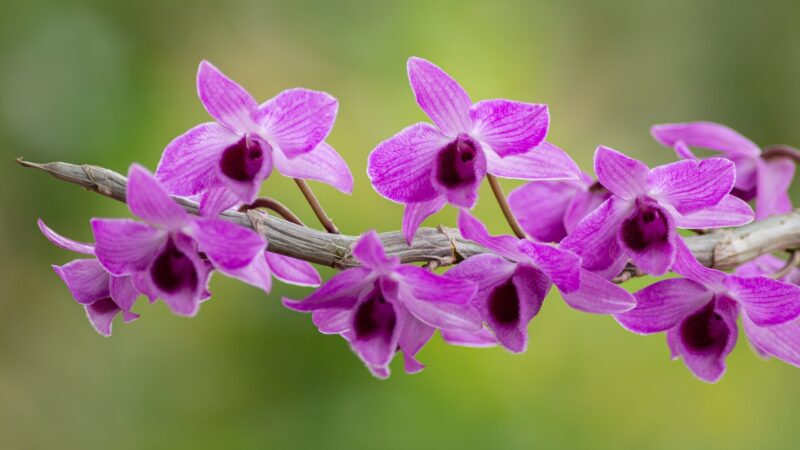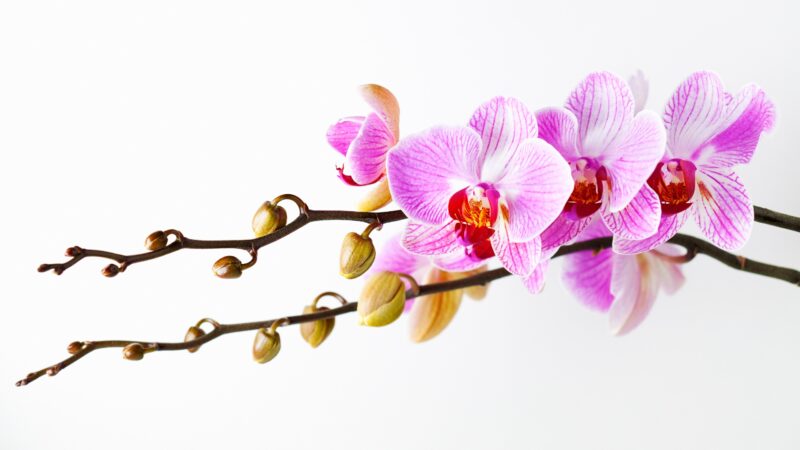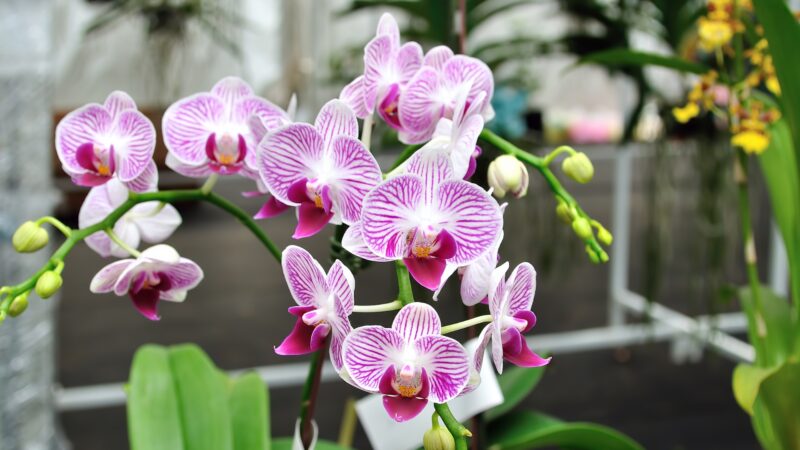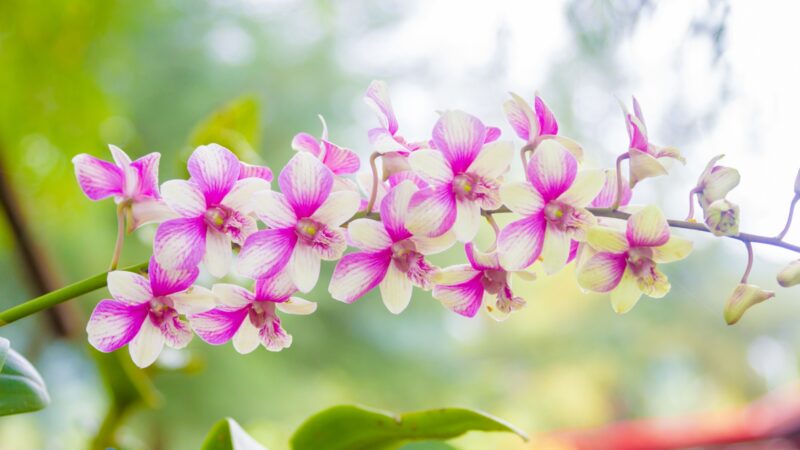Orchids are best known for colorful blooms and sweet fragrances. That makes them a beautiful addition to your garden.
Interestingly, orchids are also easy to care for – which is why they’re among the most popular plant species in the world. But to ensure the growth of your flowers, you have to take care of orchid spikes.
An orchid spike refers to a growth between orchid leaves that grow into the flower stalk over time. With proper care and maintenance, a healthy orchid spike will successfully grow buds that bloom into lovely flowers.
If you’re looking for more information on orchid spikes, then you came to the right place. In this article, you will learn exactly how to take care of your orchid spikes to ensure the growth of blooms. You will also be able to differentiate healthy spikes from unhealthy ones – and how to deal with each of them.
What Is an Orchid Spike?

An orchid spike is a growth that emerges between orchid leaves or from its crown. It is the stem that develops a bud or an inflorescence where flowers bloom.
How you take care of your orchid spikes will determine whether or not they will be able to bloom and rebloom. Thus, identifying when your orchid has grown spikes is crucial for its care and maintenance.
What Does an Orchid Spike Look Like?
An orchid spike is a stem-like branch that grows in an upright manner. These slim branches have a more flat shape than the usual round-shaped stems. Their tips are shaped like small mittens.
At the start of its growth, it’s important to determine if what’s growing is an orchid spike or an orchid’s aerial roots since the shoots look a lot similar to each other.
The easiest way to distinguish the two is that the orchid spike is a lot greener than the roots, which appear to have a silvery-white coating. Another way to tell them apart is that roots have a more rounded tip, while spikes have a mitten-like tip. And finally, orchid spikes grow between leaves while its roots grow below the leaves.
How Long for Orchid Spike to Grow?
It’s no secret that orchids take a while to grow their spikes. It takes a month before shoots start to appear and another two to three months for them to grow.
A mature orchid spike should be around four to six inches tall. However, some orchid owners allow them to grow taller to accommodate a cluster of flowers – which takes a few more months.
Related: Do Orchids Rebloom? | 13 Tips to Make Them Rebloom
Are Spikes on Orchids Good or Bad?

Generally, spikes on orchids are a good sign of growth. They usually mean that your orchid is healthy enough to produce its flowers.
However, if the orchid spikes appear dry, wilting, or damaged, that is often a bad sign. Aside from reflecting the poor condition of your orchid, these unhealthy spikes tend to suck up the plant’s energy without giving it anything in return. The energy is used to try and repair the damaged spikes, but this often is a waste of the orchid’s energy.
Thus, in the case of damaged, dry, or dead spikes, it’s best to have them removed from the plant. This allows the plant to focus its energy on improving its healthy parts and for the growth of new blooms.
How Many Spikes Can an Orchid Have?
Commonly, orchids grow about two spikes at a time. They do not need a lot of spikes because orchids tend to grow a linear cluster of flowers along these spikes.
However, there are some varieties, like those falling under the phalaenopsis species, that can grow up to four spikes at a time.
How to Get Multiple Flower Spikes on Orchids?
The more spikes an orchid has, the probability of it producing more flowers is higher. Interestingly, there are techniques by which you can grow multiple flower spikes on your orchids.
1. Pick the orchid variety you want to plant. As earlier discussed, some orchids can grow more than two spikes. This includes orchids in the phalaenopsis species, such as the moth orchid.
Thus, if you want your orchid to grow multiple flower spikes, a good option is to plant those that are already known to produce multiple spikes.
2. Feed your orchids with a fertilizer that promotes blooms. Another way to ensure the growth of multiple spikes is to use a bloom-friendly fertilizer such as the Sun Bulb Company 8305 Better Gro Orchid Plus Bloom Booster Fertilizer.
- Orchid plus bloom booster fertilizer
This fertilizer is specially formulated to ensure the growth of blooms. In turn, the growth of spikes. You may also use other fertilizers that are rich in minerals like magnesium, nitrogen, and potassium.
Should I Cut the Flower Spike off My Orchid?

It is common practice to cut off the flower spike from your orchid. Depending on its condition, it may either be completely removed or simply trimmed.
1. Complete removal. If the spike is already diseased, damaged, or dead, then the proper recourse is to remove it completely. When it is still attached to the orchid, the spike only serves to consume the plant’s energy without offering anything in return. That’s why complete removal is essential.
2. Only trim above the node. On the other hand, trimming just above the last node is preferred if the flower spike is healthy. This will help trigger the blooming cycle once again, so you can expect another set of blooms after a few months.
When to Cut Orchid Spike?
Aside from knowing what to do with your orchid spike, you should also be able to determine when it’s time to cut it off.
In the case of a dying or damaged spike, they have to be removed as soon as possible. You will know if it’s dying or damaged if it looks discolored, if the texture is mushy or dry, or if it appears to be drooping.
However, in the case of a healthy flower spike, the best time to trim it is when the temperatures begin to drop. Cool temperature triggers the growth of buds, and with proper care, that will certainly lead to new flowers. By this time, all the flowers have fallen, so it’s safe to trim the spike.
Where to Cut Orchid Spike?
Where to cut the orchid spike depends on the condition of the spike. For healthy spikes, trimming just above the node will help it develop new buds. But in the case of an unhealthy or dying spike, you have to cut it at the base to completely separate it from your orchid.
How to Cut an Orchid Spike?
Cutting off an orchid spike is quite easy. If you’re familiar with trimming flowers or pruning stems, then you won’t have a problem with cutting orchid spikes. Nevertheless, here are simple steps for you to observe:
Step 1: Identify the spike. The first thing you have to do is identify the flower spike. You have to make sure that the shoot is indeed a flower spike – otherwise, you might end up cutting the roots.
Step 2: Cut or trim accordingly. Once you have identified the spike, it’s time to cut or trim it accordingly. As a rule, healthy spikes should only be trimmed about an inch above the node. In contrast, spikes that are dead, damaged, or seemed to experience stunted growth are best removed from the plant completely.
In trimming your spikes, it’s essential to use pruning shears or blades that are sturdy and easy to grip, like the Zegos Precision Pruning Snips. You should also remember to use a quick-cutting motion to ensure a clean cut. Otherwise, your orchid might end up stressed and prevent the blooms from growing.
- 🍃[PALM-SIZE SNIP FOR HERB TRIMMING] 6.7" long in full-length...
- 🍃[STAINLESS-STEEL STRAIGHT BLADES] Heat-treated hardened steel...
- 🍃[COMFORTABLE GRIP WITH BUILT-IN SPRING] Reduce hand fatigue...
- 🍃[SAFETY LATCH TO LOCK BLADES] Keep your blades closed when...
- 🍃[BRIGHT COLOR APPEARANCE] Easily find your brightly-colored...
Whether the spike is healthy or not, you should always remember to use sanitized shears or blades in doing so. Otherwise, you risk contaminating your orchid with whatever microorganism or pathogen is in your gardening tools.
What to Expect After Trimming the Flower Spike?
After you trim a healthy flower spike, this usually triggers it to produce new buds once the conditions are ideal. And with the right care, these buds will grow into flowers after a few months. These flowers usually stay open for about eight to twelve weeks before they fall off.
How to Make an Orchid Grow a New Spike?

To make your orchid grow a new spike, you have to give it extra care and attention. Here are some tips and tricks you can follow to ensure its healthy growth:
- Place the plant where it’s cool. The natural trigger that signals orchids that it’s time to grow spikes are when the temperature starts to drop. As such, if you place your orchid where the temperature is cooler than its usual environment, then that will trigger a response from your orchid to grow new spikes.
However, make sure to keep the temperature between 55 to 65°F only. If the temperature is lower than this range, this may cause the orchid to be too cold, especially if it is exposed for extended periods. As a result, your orchid might end up withered – and won’t produce new spikes at all.
- Water them regularly. Orchids do not need a lot of water. However, that doesn’t mean that they have to be neglected. Continue to give your orchid enough water once a week or twice a month to keep them hydrated.
- Feed them fertilizer. By themselves, orchids can survive and be healthy even without fertilizer. But if your goal is to trigger the growth of new spikes, you may need a boost from bloom-boosting fertilizer. The Scotts Miracle Grow Orchid Spike is a good option to consider since it is specifically formulated to ensure the growth of orchid spikes.
Alternatively, you may opt for other fertilizers that are rich in magnesium, nitrogen, potassium, and phosphorus. However, it must be noted that you should feed your orchids according to the suggested dosage for the fertilizer. Otherwise, you might overfeed your orchid or burn its roots.
- Note the humidity levels. Bear in mind that orchids need high humidity to breathe. If the air is too dry, its stomata tend to close. With the stomata closed, your orchid also stops breathing, which that can lead to your orchid’s wilting and death. Typically, try to maintain the moisture levels in the air between 50 to 70%.
- Continue observing for new spikes. During this period, you must keep observing your orchid in case it grows new shoots or spikes. Once you are certain that the growth is a new spike – and not its aerial roots – then it’s time to move it to a place where it’s warmer.
How to Take Care of New Spike Grow On Orchid?
Once you have successfully grown an orchid spike, you must know how to take care of it. Bear in mind that orchid spikes will mature within two to three months, so they will not bear any flowers until then.
During this time, it is crucial to take care of the spike to prevent it from dying or suffering from stunted growth. Here are some tips for you to consider:
- Water regularly. During this time, your orchid should stay hydrated. While they only need as little as three ice cubes worth of water per seven to ten days, you should remember to water them religiously. Otherwise, they will become dehydrated, which can cause your orchid to wilt. As a result, it will not deliver the nutrient needed for the new spike’s growth.
- Maintain the temperature between 65 to 75°F. Orchids thrive where it’s warm. Once it has grown a new spike, it should be transferred to a warmer place to keep it healthy and happy. Also, make sure that it’s humid, maintaining the humidity levels between 50 to 70%.
- Opt to use stakes to support its growth. Once the new spike has grown long enough, you should use stakes and a loose clip or tie to help it grow. Good stakes like the Mudder Metal Plant Stakes will keep the spikes growing upright and prevent them from looking droopy.
- Quality Material: this plant stake is made of metallic steel and...
- Size and Package: you will receive 50 pcs orchid clips, 10 pcs...
- Abundant Accessories: after you have driven garden stakes into...
- Easy to Use and Move: simply insert into the soil or the flower...
- Applications: the garden stakes bendable single stem plant...
- Lighting. Most importantly, you should know what kind of light your orchid needs. Orchids prefer shaded areas where they can still get enough warmth and sunlight. As such, make sure that your orchid isn’t directly exposed to the sun for too long. Otherwise, they might suffer from sunburn and dehydration.
List of Sources
Structure And Function: What Makes an Orchid an Orchid
Inflorescences: concepts, function, development and evolution



